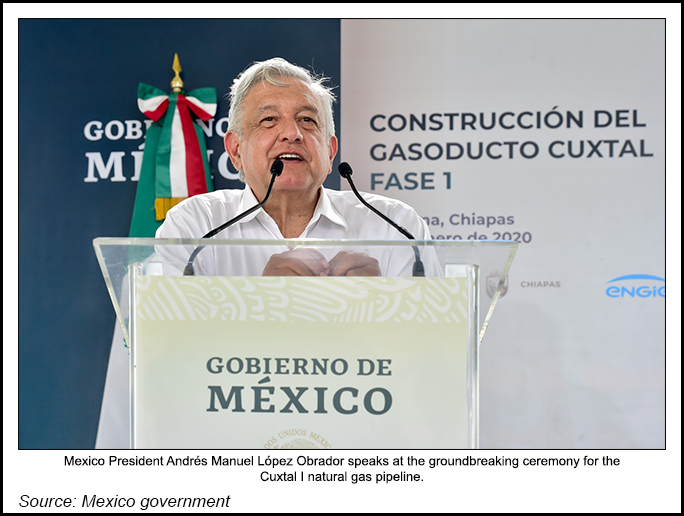NGI The Weekly Gas Market Report | Infrastructure | NGI All News Access
Mexico’s AMLO Says Mayakan Interconnect to Enter Service in August, Easing Yucatán Gas Supply Woes
A 10-mile interconnection between the Mayakan natural gas pipeline on Mexico’s Yucatán Peninsula and the Sistrangas national pipeline grid will enter service by August 2020, president Andrés Manuel López Obrador said Friday.

Mexico’s state-owned power company, Comisión Federal de Electricidad (CFE), and French multinational Engie SA will jointly develop the interconnecting pipeline, known as Cuxtal I, which will have an initial transport capacity of 240 MMcf/d and require about 500 million pesos, or $26.6 million, of investment, according to CFE general director Manuel Bartlett.
Engie also owns and operates Mayakan, the peninsula’s only source of natural gas.
Mayakan receives gas from the Nuevo Pemex natural gas processing center in Tabasco state owned by national oil company Petróleos Mexicanos (Pemex).
Gas injections from Nuevo Pemex to Mayakan “have been on the decline due to the fall in production” from Pemex oil and gas fields in southeastern Mexico, CFE said Friday.
Although Mayakan has the capacity to transport 250 MMcf/d of gas, transported volumes on the pipeline have fallen to around 52 MMcf/d, energy ministry Sener said. As a result, the peninsula has had to rely on costlier and dirtier fuel oil and diesel fuel to meet power demand, Sener said, causing electricity prices to spike in the states of Campeche, Yucatán and Quintana Roo.
Cuxtal I, however, will allow Mayakan to also receive molecules from Pemex’s Cactus processing facility in Chiapas state.
The Cuxtal I pipeline, combined with “future investment in compression infrastructure” on the Sistrangas, will allow the Yucatán region to access “the cheapest gas in the world” from the United States via the Sur de Texas-Tuxpan marine pipeline and the Net Mexico Pipeline Partners, LLC intrastate pipeline in Texas, Sener said.
“The functionality” of the Mayakan interconnection “depends on the completion and full operation of the adjustments to” the Cempoala compression station, which “will allow gas to flow from the north to the south of the Gulf of Mexico, and then to the Yucatán Peninsula,” Talanza Energy Consulting’s David Rosales and Daniela Flores said recently in a research note, adding that the Cempoala reconfiguration is scheduled for completion in the first half of 2020.
Since the marine pipeline entered service last September, Pemex has been able to supply more gas to Mayakan through a swap arrangement with CFE, the anchor customer of the marine pipe.
However, the quality of the gas injected at Cactus still often misses quality standards due to high concentrations of nitrogen, the Talanza analysts said.
The Cuxtal I project is subject to the Sistrangas non-discriminatory open access rules created under Mexico’s 2013-2014 constitutional energy reform, Rosales and Flores said, adding that under the law, capacity on the 10-mile pipeline should be awarded through an open season process by the Centro Nacional de Control del Gas Natural (Cenagas), independent operator of the Sistrangas.
© 2024 Natural Gas Intelligence. All rights reserved.
ISSN © 2577-9877 | ISSN © 2577-9966 | ISSN © 1532-1266 |
